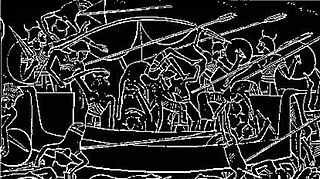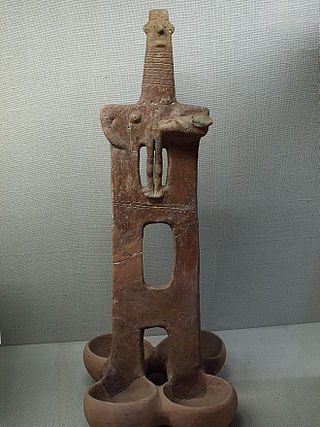
Human habitation of Cyprus dates back to the Paleolithic era. Cyprus's geographic position has caused Cyprus to be influenced by differing Eastern Mediterranean civilisations over the millennia.

The Sherden are one of the several ethnic groups the Sea Peoples were said to be composed of, appearing in fragmentary historical and iconographic records from the Eastern Mediterranean in the late 2nd millennium BC.

The Sea Peoples are a hypothesized seafaring confederation that attacked ancient Egypt and other regions in the East Mediterranean before and during the Late Bronze Age collapse. Following the creation of the concept in the 19th century, the Sea Peoples' incursions became one of the most famous chapters of Egyptian history, given its connection with, in the words of Wilhelm Max Müller, "the most important questions of ethnography and the primitive history of classic nations".

The Greek Dark Ages was the period of Greek history from the end of the Mycenaean palatial civilization, around 1100 BC, to the beginning of the Archaic age, around 750 BC. Archaeological evidence shows a widespread collapse of Bronze Age civilization in the Eastern Mediterranean world at the outset of the period, as the great palaces and cities of the Mycenaeans were destroyed or abandoned. At around the same time, the Hittite civilization also suffered serious disruption, with cities from Troy to Gaza being destroyed. In Egypt, the New Kingdom fell into disarray, leading to the Third Intermediate Period of Egypt. Following the collapse, there were fewer, smaller settlements, suggesting widespread famine and depopulation. In Greece, the Linear B script used by Mycenaean bureaucrats to write the Greek language ceased to be used, and the Greek alphabet did not develop until the beginning of the archaic period. The decoration on Greek pottery after about 1100 BC lacks the figurative decoration of Mycenaean ware and is restricted to simpler, generally geometric styles (1000–700 BC).

The Prehistoric Period is the oldest part of Cypriot history. This article covers the period 10,000 to 800 BC and ends immediately before the documented history of Cyprus begins.

Pyla is a village in Larnaca District, Cyprus. It is one of only four villages located within the United Nations Buffer Zone, the other three being Athienou, Troulloi and Deneia. Pyla is located in the eastern part of the island, adjacent to the British Sovereign Base Area of Dhekelia. From a legal point of view, it is administered as all other areas controlled by the government of the Republic of Cyprus, but policed by UN peacekeepers.
Xylotymbou is a small town in Larnaca District in south-eastern Cyprus. It is one of the four enclaves surrounded by the Eastern Sovereign Base Area of Akrotiri and Dhekelia, a British Overseas Territory, administered as a Sovereign Base Area. The others are the village of Ormidhia and two separate parts of Dhekelia Power Station. It is administered by the internationally recognized government of Cyprus, the Republic of Cyprus.

Athienou is a village in Larnaca District, Cyprus. It is one of only four villages located within the United Nations Buffer Zone, the other three being Pyla, Troulloi and Deneia. Today, Athienou has a population of around 6,500 people. Since 1990, it has been home to Davidson College's Athienou Archaeological Project BY GIORGOS MAVRAGANIS. The town's city hall includes a museum of local history and culture that was established in 2008.

The Late Bronze Age collapse was a time of widespread societal collapse during the 12th century BC, between c. 1200 and 1150. The collapse affected a large area of the Eastern Mediterranean and the Near East, in particular Egypt, eastern Libya, the Balkans, the Aegean, Anatolia, and the Caucasus. It was sudden, violent, and culturally disruptive for many Bronze Age civilizations, and it brought a sharp economic decline to regional powers, notably ushering in the Greek Dark Ages.
This is a timeline of Cypriot history, comprising important legal and territorial changes and political events in Cyprus. To read about the background to these events, see History of Cyprus. See also the list of presidents of Cyprus.
The town of Limantepe, sometimes spelled Liman Tepe, located on Turkey's western coast is the site of a prehistoric settlement that includes an ancient port dating from 2500 years located underwater offshore. The area is situated in the urban zone of the coastal town of Urla near İzmir. In pre-classical antiquity and during the Hellenistic and Roman eras, it was a Greek town called Larisa.
Alampra or Alambra is a village located in the Nicosia District of Cyprus.

Apliki is a small village in the Nicosia District of Cyprus, located 2.5km North-East of Palaichori Oreinis and is at an altitude of 720 meters above sea level.

The Nuragic civilization, also known as the Nuragic culture, was a civilization or culture on the Mediterranean island of Sardinia, Italy, which lasted from the 18th century BC up to the Roman colonization in 238 BC. Others date the culture as lasting at least until the 2nd century AD and in some areas, namely the Barbagia, to the 6th century AD or possibly even to the 11th century AD.

Pyla-Kokkinokremos was a Late Bronze Age settlement on Cyprus, abandoned after a brief occupation.

Cypriot Bichrome ware is a type of Late Bronze Age, and Iron Age, pottery that is found widely on Cyprus and in the Eastern Mediterranean. This type of pottery is found in many sites on Cyprus, in the Levant, and also in Egypt. It was typically produced on a pottery wheel. A large variety of decorations and motifs are attested. This pottery is very similar to certain types of the Mycenaean pottery from various locations.

Limassol District or Lemesos is one of the six districts of Cyprus. As of 2011, it had a population of 239,842, 77% of which was urban. Its main city is Limassol. Part of the British Overseas Territory of Akrotiri and Dhekelia forms an enclave on the Akrotiri Peninsula, under the sovereignty of the United Kingdom.

Kilise Tepe is a mound in Mersin Province, Turkey, just west of the Göksu River, lying 20 kilometers from Mut and 145 kilometers from Mersin. It was initially known as Maltepe which is actually the name of a site on the other bank of the river about four kilometers to the west. The original name of the mound is not known and Kilise Tepe in Turkish means "church-hill" referring to a church ruin. The site is thought to have been part of the land of Tarḫuntašša, formed when Muwatalli II moved the Hittite capital.
The archaeology of Cyprus involves the analysis of human activity derived from Cypriot artefacts and architecture from the Neolithic through to the British period. The earliest archaeological discoveries in Cyprus are attributed to European amateur collectors or “treasure hunters” during the early 19th century. By the mid 19th century, systematic fieldwork and excavations were conducted on various sites involving studying the remains of Cypriot cemeteries and tombs, maritime artefacts, architecture, pottery as well as a range of other individual artefacts. Subsequent findings and analysis detail the social and physical landscapes of ancient Cyprus as well as their evolving culture, religious beliefs and technology throughout antiquity.















